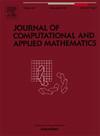Sylvester算子的逆迭代
IF 2.6
2区 数学
Q1 MATHEMATICS, APPLIED
Journal of Computational and Applied Mathematics
Pub Date : 2025-08-05
DOI:10.1016/j.cam.2025.116950
引用次数: 0
摘要
我们将矩阵的逆迭代推广到(广义)Sylvester算子S(X)≡AXB∞∞- CXD∞∞,计算S(X)=0的零空间或齐次解,或相交子谱Λ(A,C)∩Λ(D,B)的特征空间。考虑了(A,C)和(D,B)中有两个小矩阵铅笔、一个大铅笔和一个小铅笔、两个大铅笔的情况,以及Sylvester方程和Lyapunov方程以及张量结构线性方程的特殊情况。当相应的Sylvester方程的求解过程鲁棒且有效时,广义逆迭代在一次或两次迭代中收敛,特别是对于小维或具有半简单相交特征值的情况。对于大的例子,特别是具有贬义相交特征值的例子,该方法的性能不太好。给出了说明性数值实验。本文章由计算机程序翻译,如有差异,请以英文原文为准。
Inverse iteration for Sylvester operators
We generalize the inverse iteration for matrices to the (generalized) Sylvester operator , computing the null space or the homogeneous solution to , or the eigen-spaces for the intersecting subspectrum . Cases with two small matrix pencils in and , a large and a small pencils, and two large pencils, as well as the special cases for the Sylvester and Lyapunov equations, and the linear equation with tensor structures, are considered. When the solution process for the corresponding Sylvester equation is robust and efficient, the generalized inverse iteration converges in one or two iterations, especially for cases of small dimensions or with semi-simple intersecting eigenvalues. For large examples, especially with derogatory intersecting eigenvalues, the approach performs less well. Illustrative numerical experiments are presented.
求助全文
通过发布文献求助,成功后即可免费获取论文全文。
去求助
来源期刊
CiteScore
5.40
自引率
4.20%
发文量
437
审稿时长
3.0 months
期刊介绍:
The Journal of Computational and Applied Mathematics publishes original papers of high scientific value in all areas of computational and applied mathematics. The main interest of the Journal is in papers that describe and analyze new computational techniques for solving scientific or engineering problems. Also the improved analysis, including the effectiveness and applicability, of existing methods and algorithms is of importance. The computational efficiency (e.g. the convergence, stability, accuracy, ...) should be proved and illustrated by nontrivial numerical examples. Papers describing only variants of existing methods, without adding significant new computational properties are not of interest.
The audience consists of: applied mathematicians, numerical analysts, computational scientists and engineers.

 求助内容:
求助内容: 应助结果提醒方式:
应助结果提醒方式:


